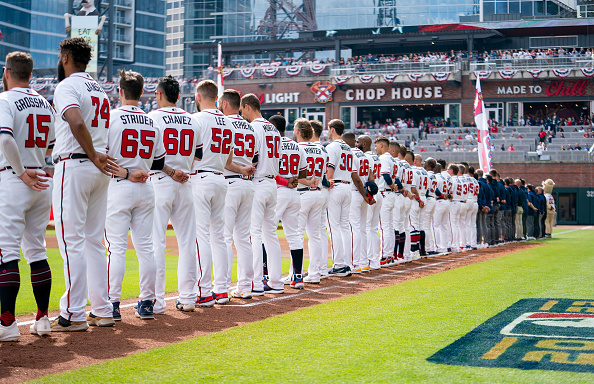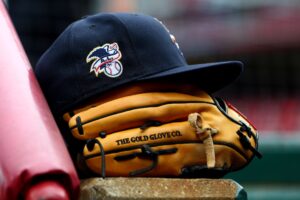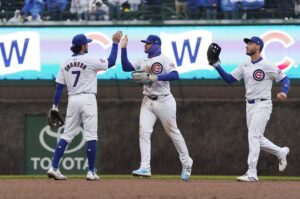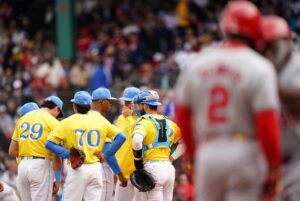The Atlanta Braves core is one of the many reasons they are back in postseason play this year. They have impacted the team in more ways than one already. General Manager Alex Anthopolous, no doubt focusing on this, has made waves by signing many to massive, long-term deals. These contracts are not only team friendly but fan friendly as well. Citizens of Braves Country will flock to see players like Austin Riley, Michael Harris, and Spencer Strider for years to come. All of these players are focal points as members of the team’s core, so Braves fans shouldn’t worry about another rebuild for a long time.
The key term in the preceding sentence is “shouldn’t.” Some of these players could indeed falter under pressure. Still, others may be bitten by the ever-present, yet equally elusive and surprising, injury bug. Nevertheless, very few cores in the game match the Braves’ core. Each player brings something unique to the table, full of power, speed, and a genuine love for the game. The combination of these, again, should bring the Braves plenty of benefits in the future. Let’s jump in and examine some of the core’s key elements at a closer level.
Atlanta Braves Core Key Elements
Leadership
First is a player that many might deem the leader of the young Braves core: Austin Riley. The young third baseman inked a 10-year, $212 million deal with the team this season. It’s a well-earned contract, as 2022 became Riley’s breakout campaign. In only his fourth big league season, he placed in the NL’s top five in WAR (6.5), slugging (.528), and homers (38). He created 115 runs this season. Only Paul Goldschmidt and Freddie Freeman created more. He also led the league in extra-base hits (79) and total bases (325). Not only that, but this is coming off the heels of 2021, in which he finished seventh in National League MVP voting.
Atlanta can benefit in so many ways from this young slugger. It’s no secret that he has proven that he can hit well and who is more than capable of defending the hot corner. However, his meteoric improvement at the plate is the most exciting thing about him. For instance, in 2020, he hit .074 on offspeed pitches. In 2021, he jumped to an astonishing .341 on the same type. His average has fallen this season but remained at a respectable .273. He also continues to crush fastballs, with 18 of his 38 homers coming off the pitch this season. So, in short, Riley is in a prime position to help lead this young Braves core into the future.
Rookie Prominence
In the spot of the most exciting up-and-comer, we find Michael Harris. This season, he exploded onto the scene after jumping from Double-A Mississippi. The amount of tools that the rookie center fielder has is mind-boggling. He finished the regular season as the best rookie position player in the NL by fWAR (4.8). His defense has been phenomenal, posting an Ultimate Zone Rating of 4.9. That was fifth in the National League among outfielders, ranking higher than speedy counterparts Victor Robles and Trent Grisham. His OAA of seven was good for seventh in the league, ahead of Robles and Brandon Nimmo.
Before we get too enveloped in Harris’s excellent glove, let’s not forget about his bat. He slashed .297/.339/.514 with a wOBA of .367. Only Joey Meneses of the Washington Nationals had a higher average, and he played in 58 fewer games than Harris. So, those statistics might be a tad bit skewed. In any case, Harris had the highest offensive WAR among NL rookies, putting up a staggering 24.4 mark. In perspective, runner-up Jake McCarthy was over 10 points behind Harris. That’s how excellent Harris was this season. If he continues on this torrid trajectory, the Braves core should have themselves an outfielder to rival Andruw Jones.
Pitching
Last, but not least, we focus on the pitching aspect. Names like Max Fried and Kyle Wright have received much-deserved press. Yet, there’s now a third name to add to this sudden three-headed (or, specifically, three-armed) dragon: Spencer Strider. Regarding rookie hurlers in the NL this season, Strider put everyone else to shame. His fWAR of 4.9 was over three points better than runner-up Nick Lodolo’s 1.8. He struck out batters at a 38.3% clip this season, easily the best among those first-year arms. Opponents only hit .179 off him, placing him firmly in the top five in his category.
Overall, the key to Strider’s success has been his overwhelming fastball. According to Fangraphs, it is the most valuable heater among NL rookie pitchers (wFA: 22.7). This places him second only to the Minnesota Twins’ Joe Ryan in all of baseball. It’s dynamic, topping at an average velocity of 98 miles per hour. That was good for the 97th percentile among all pitchers. He also had a whiff percentage rate in the 95th percentile and held teams to a run value of -20 with the pitch. That was only four points, not tying Justin Verlander for the Major League lead. The only question is whether or not he will be able to back it up in the future.
Excitement For Years to Come
In summation, the Atlanta Braves core is full of absolute powerhouses. We’ve only covered three here, but there are so many more. Between Fried, Wright, and Strider, the rotation will be an absolute embarrassment of riches for years to come. Conversely, crushing lumber courtesy of Riley, Harris, and others like Vaughn Grissom ensures a torrent of offensive success. Many of those same players flash leather regularly as well. Some may be future league MVPs, Gold Glove winners, or both. One thing is certain, though. They will entertain fans as the Braves continue to try and chase down championships over the next decade.
Main Photo
Players/managers mentioned:
Austin Riley, Michael Harris, Spencer Strider, Victor Robles, Trent Grisham, Brandon Nimmo, Joey Meneses, Jake McCarthy, Andruw Jones, Max Fried, Kyle Wright, Nick Lodolo, Joe Ryan, Justin Verlander, Vaughn Grissom






